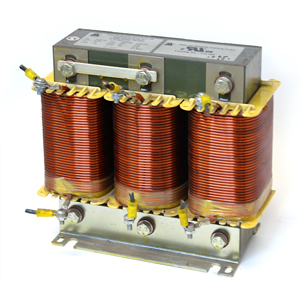A line reactor (also referred to as a "choke") is a variable frequency drive (VFD) accessory that consists of a coil of wire that forms a magnetic field as current flows through it. This magnetic field limits the rate of rise of the current, thus reducing harmonics and protecting the drive from power system surges and transients. There are two primary types of reactors used in variable frequency drives: AC & DC. When an AC reactor is placed between the power system and the drive, it is referred to as an AC line reactor. When a DC reactor is inserted into the DC link of a variable frequency drive, it is known as a DC link reactor. Both AC and DC reactors limit harmonic currents. However, AC reactors have the significant advantage of protecting the entire VFD from power system surges and transients since they are placed between the power system and the incoming power terminals at the drive. Reactors can prevent overvoltage trips, increase the reliability and life span of the VFD, improve total power factor, and reduce nuisance tripping.
Showing the single result

